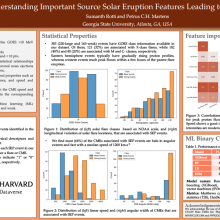Understanding Important Source Solar Eruption Features Leading to SEP Events.
Sumanth
Rotti
Georgia State University
Poster
Reliable predictions of SEP events are vital to mitigate and avoid space weather hazards, including high energy particle exposure of astronauts and spacecraft equipment outside the Earth's magnetosphere. As SEP events are often associated with solar eruptions such as flares and coronal mass ejections (CMEs), understanding the precursors and their various parameters that dictate the SEP acceleration is of crucial importance.
We have identified over 400 SEP events between 1986 and 2018, and developed an extensive, publicly available catalog carefully associating each event with a solar source, wherever possible. We made use of existing catalogs of flares, CMEs and radio bursts to obtain the necessary features associated with SEP events. We considered the proton fluxes from the Geostationary Operational Environmental Satellites (GOES) and inspected each individual event in detail to extract the event statistics.
Following up on this we are analyzing the relationships of different solar source parameters associated with SEP events and the correlations between these quantities. Furthermore, we are undertaking feature importance studies using tree-based machine learning (ML) models useful for predicting SEP events. In this poster, we experiment with decision trees (DT), random forests (RF) and extreme gradient boosting (XGBoost) classifiers in a binary classification problem domain. The motivation behind this is that the ML models can learn and make decisions based on data and issue quicker forecasts to improve upon existing statistical models.
We have identified over 400 SEP events between 1986 and 2018, and developed an extensive, publicly available catalog carefully associating each event with a solar source, wherever possible. We made use of existing catalogs of flares, CMEs and radio bursts to obtain the necessary features associated with SEP events. We considered the proton fluxes from the Geostationary Operational Environmental Satellites (GOES) and inspected each individual event in detail to extract the event statistics.
Following up on this we are analyzing the relationships of different solar source parameters associated with SEP events and the correlations between these quantities. Furthermore, we are undertaking feature importance studies using tree-based machine learning (ML) models useful for predicting SEP events. In this poster, we experiment with decision trees (DT), random forests (RF) and extreme gradient boosting (XGBoost) classifiers in a binary classification problem domain. The motivation behind this is that the ML models can learn and make decisions based on data and issue quicker forecasts to improve upon existing statistical models.

Poster PDF
Poster category
Space Weather Policy and General Space Weather Contributions
Meeting homepage